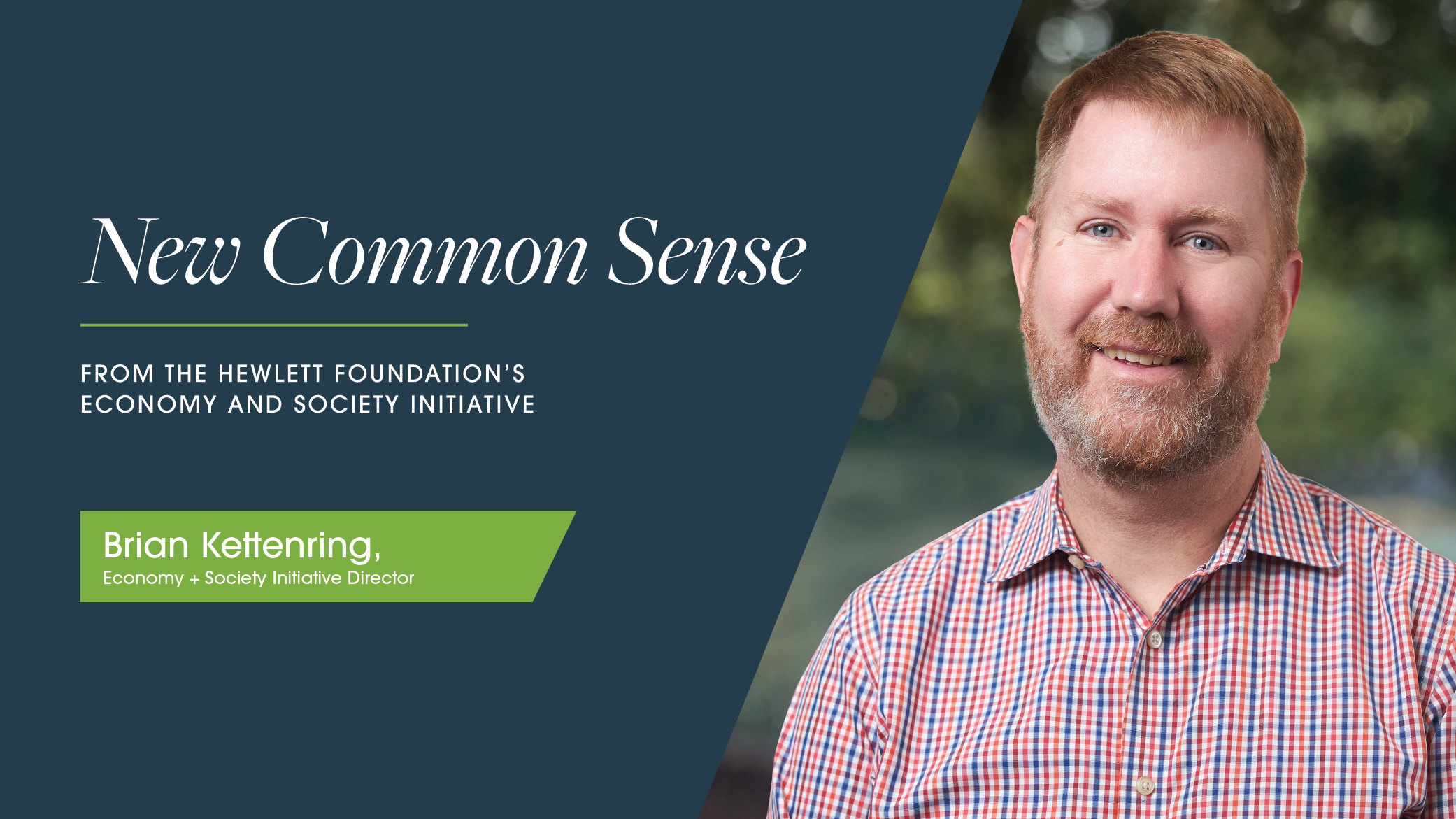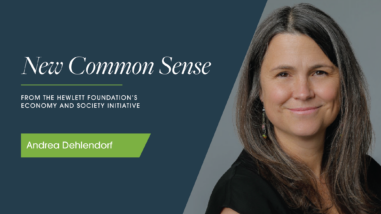Industrial policy and the new paradigm

In this note, I want to update our readers on what we’re doing here at the Economy and Society Initiative (ESI) on industrial policy and, more specifically, what we’ll call green industrial policy (GIP). I also want to pull the lens back a bit and look at the relationship between industrial policy and shifts in the broader economic paradigm, as well as think out loud about the medium-term agenda for industrial policy.
Our part in the story dates to the summer of 2022, when informal conversations began among a set of funders about the need to take a look at industrial policy as a question. There wasn’t really a structured approach to this question in philanthropy at that point, though I want to credit my predecessor Jen Harris for writing it into the strategy for the Economy and Society Initiative from the beginning (see page 16 of the December 2020 ESI strategy document). By the summer of 2022, Build Back Better looked dead and the CHIPS Act had yet to pass. But our sense was that the sands were shifting, particularly in the United States. President Biden had already stated a desire to “change the paradigm.” Republican Senator John Cornyn, for example, had co-sponsored the CHIPS Act. It was clear that a confluence of dynamics — climate change, competition with China, the COVID-19 pandemic — had shifted the terrain. So we decided to get smart and get organized.
Things quickly evolved from there. First, Build Back Better came back to life as the Inflation Reduction Act and passed by a whisker in August 2022. Then the CHIPS Act passed that same month. Throughout the fall, we consulted with a widening circle of philanthropies and we talked to experts and grantees about their thinking. Felicia Wong, Todd Tucker, and others at the Roosevelt Institute organized an important framing conference in Washington that October, bringing together policymakers, scholars, think tankers, funders, and the media. What had in the summer looked like a longer-term enterprise of revivifying industrial policy had by the fall become a question of how can philanthropy and civil society most effectively engage the public in the project of implementation, but also address the technical and institutional barriers to making these laws work. By early in the new year, multiple efforts had emerged, including three efforts that Hewlett engaged with.
Carrie Doyle, my colleague at Hewlett’s Environment Program, co-led the establishment of a major new implementation fund populated mainly by climate funders. Invest in Our Future is now a thriving enterprise that will mobilize $180 million over the next three years to ensure recent federal investments reduce climate-warming emissions, while supporting the economic and social well-being of communities across the U.S. My colleague at Hewlett’s U.S. Democracy Program, Ali Noorani, smartly saw the opportunity to strengthen the operations and standing of a crucial governmental institution, the Internal Revenue Service, and partnered accordingly with other funders and grantees who saw the same opportunity. For our part, the Economy and Society Initiative worked mainly with economy funders to create a pooled fund called BuildUS, which has raised $50 million over three years and plans to invest upwards of $20 million by the turn of the year.
BuildUS, staffed initially by founding Executive Director Jen Harris and a small but high-powered team, is working across four arenas that are broadly similar to the work Invest in our Future is supporting: (1) community uptake of the Inflation Reduction Act, with a primary focus on the climate provision of the law, (2) worker power, (3) communications, and (4) addressing the bottlenecks that could hinder implementation. It’s worth a mention why BuildUS, primarily an industrial-policy oriented fund focused on questions of political economy, is homing in on the climate provisions of the IRA.
The implications of the changes brought by the CHIPS Act, the infrastructure law, and the IRA are immense — from the development of the Regional Innovation and Technology Hubs to price caps on insulin in the IRA, and countless other provisions in between. That said, in the arena of green industrial policy, we are literally creating entirely new industries or, in some cases, dramatically remaking existing fields. If you care about the most strategic opportunity to strengthen the hand of workers, look to the green transition (and, I should note, the emerging contours of the United Auto Workers’ new agreements with the big three automakers). From the standpoint of racial justice, too, the economics of the green transition are a point of fundamental concern.
I spent 25 years organizing for higher wages and a strengthened social safety net. But I was always frustrated that our policy tools were insufficient to the task. Some of this is the nature of campaigning, which tends to lend itself to policy solutions that the public can readily understand. Increasing the minimum wage, for example, would raise wages for millions, but it wouldn’t affect precarious workers higher up the wage ladder, nor would it alter broad economic forces like deindustrialization or financialization that were suppressing wages and increasing inequality.
Back in this period, legal scholar Joel Rogers characterized our challenge as one of fostering “high-road economic development,” rather than the low road. Our task, Rogers counseled, was to incentivize the high road and shut down the low road. This has stayed with me all these years and that characterizes one dimension of what’s at stake with the implementation of the IRA and with the so-called return of industrial policy.
The battle over the future of the electric vehicle industry is perhaps fundamental, if for no other reason than the economic and symbolic importance of auto industries to various nations’ fates. Look, for example, at the importance of the German auto industry to that country and the existential threats it now faces. In the United States, too, the battle over the future of the auto industry is underway. And fortunately, the new UAW leadership seems ready to engage its membership and fight for a more inclusive green transition. The historic wins of the UAW at the big three augur well for this test. Right now, there are documented reports of child labor being used in auto and automotive supply chain manufacturing in Alabama. That is the precise opposite of high-road development, and should it stand, it will be a disaster for the green transition.
In the coming months, we’ll roll out a series of grants from BuildUS across those four named verticals. I want to flag one exciting project, however: a substantial investment to engage community organizing groups around the country in new models of implementation. I’m excited about this for a number of reasons. For example, if you think about the dynamics of winning a high-road green transition, there is the supply side of workers (as per above), supply chains, and the like. But this strategy with the organizing groups focuses on the demand side, consumers of energy, in particular. We will be testing a few theories with these projects, but the underlying question has to do with how most effectively to engage communities to fight for a high-road green transition that lowers their energy costs and carbon footprint.
One of the things that’s unique about Hewlett’s Economy and Society Initiative is our enduring attention to the power of ideas and to the role played by dominant intellectual paradigms in defining the realm of the possible. Though we deeply appreciate a good policy victory, and we’ve embraced the notion of public engagement and building power for workers and communities to buttress new economic thinking, we do aim to keep our eyes on the paradigm prize.
How then, does industrial policy and GIP relate to a shift to a new, more inclusive and sustainable form of political economy? Some of this is obvious, for example the legitimation of thoughtful state intervention to craft markets and build industries. Some is less obvious.
Not only does successful industrial policy implicate the role of the “entrepreneurial state,” to use Mariana Mazzucato’s term, but it also begs questions of state capacity. In the U.S. and around the world, policymakers are grappling with how to strengthen governmental capacity to deploy resources, hold industry accountable, and the like.
We haven’t talked a lot about trade in New Common Sense (NCS), but it’s clear that many provisions in the IRA and the CHIPS Act represent, at a minimum, a shot across the bow of the World Trade Organization — the ultimate institution of free trade-loving globalization. And with the green transition, there is a debate about how countries can take an advantageous seat at the global economic table. This begs questions of economic development models at the level of the nation-state. It also provides the basis for rewriting the neoliberal conception of trade that, with some notable exceptions, hurts millions of workers the world over.
We mentioned the question of financialization above, the focus of an earlier edition of NCS. Green industrial policy is very much bound up with questions of the role of finance. In short, if we are to meet key national development goals such as the green transition, finance has to be mobilized toward these ends. In an absolute laissez-faire form of finance, capital is allocated not merely for “efficiency,” but too often for unproductive or counterproductive purposes. Linking industrial policy to an accountable form of finance will incentivize investment in productive and socially useful activities.
This raises a final point, a deeper question of economics and measurements like gross domestic product, that is the question of value. Industrial policy is in part about setting goals as a society — through the democratic process — and carrying these out in our economic activities. But it’s also about how to achieve economic growth, how to raise the standard of living for our communities, and in the era of “global boiling” and of degrading (in multiple senses) consumerism, how to separate prosperity from destructive or unnecessary consumption. For these many reasons, it’s important that the United States and some other countries have rejoined the industrial policy party.
In many respects, the United States is only in the early stages of its re-embrace of industrial policy, affording us the opportunity to learn and improve. In the immediate term, we must successfully implement the spate of laws that have recently been passed by Congress. It’s worth noting that we’re already seeing some fly-wheel effects from the IRA, for example in the form of $500 billion in private investments announced in the past year. In the years ahead, there will be work to do to strengthen the U.S. government’s ability to plan and nurture emerging industries. Beyond this, there is a need to think through the next generation of policies that build on the laws of the 2021-22 period. This can happen at the federal level, but also in states and cities, and in international trade fora. In other words, the stakes are so high, and the timelines so urgent, that battles must be taken up on every possible front.



